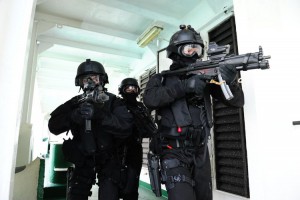New dedicated anti-terrorist police units along with tighter building and event security features are among plans revealed by Home Affairs Minister K Shanmugam to increase the nation’s preparedness for an attack.
More steps will be taken to ramp up Singapore’s counter-terrorism security measures in view of the threat of an attack here being at its highest level in recent times, announced Home Affairs Minister K Shanmugam on Friday (Mar 18).
“ISIS wants to establish a caliphate in this region, encompassing Singapore … We are in the epicenter of the caliphate that ISIS wants to establish,” he said, going on to describe the increasing regional terror threat. He pointed out that there were at least 74 terror-related arrests in Indonesia last year, and Malaysia foiled seven terrorist plots last year, including one to kidnap Prime Minister Najib Razak, and there were more than 100 arrests.
“Every day, we have more than 400,000 people crossing both ways at our land checkpoints in Woodlands and Tuas. In Woodlands alone, we have about 90,000 travellers via motorcycles; 80,000 by cars, every single day. So you can work out for yourself the nature of the threat to us from a would-be terrorist in Malaysia,” said Mr Shanmugam.
PROTECTING BUILDINGS, EVENTS
While Mr Shanmugam praised Singapore’s counter-terrorism strategy for “quite effectively” dealing with the challenges thus far, he noted that the authorities must now “urgently” deal with increased threats and new tactics including staging multiple attacks simultaneously over different locations and targeting vulnerable, crowded venues.
Therefore, security measures will be significantly enhanced in the areas of protection and vigilance as well as response, he said.
First, buildings – notably critical infrastructure like Changi Airport and Government buildings as well as soft targets like entertainment centres and shopping centres – will see a “significant” expansion of CCTV coverage. The process of installing police cameras at 10,000 Housing and Development Board (HDB) blocks and multi-storey carparks will be completed this year. This will then be extended to more heartland areas like town centres, hawker centres and walkways leading to transport hubs.
CCTV data in more areas will also be accessible to the police on demand, including from systems monitoring public transport, busy commercial buildings, and Government buildings.
“Members of the public will also be able to submit videos to the police on crowd-sourcing platforms,” said the minister.
“This is a necessary, strategic, and direct response to the evolving nature of the threats.”
Secondly, rules will be introduced to require building owners and organisers of major events to implement security measures – such as CCTV systems that meet key technical standards and venue screening.
Mr Shanmugam acknowledged that the proposed increased security measures will increase building and operating costs, but said this ‘unfortunately cannot be avoided. The terrorists have imposed multiple costs on society”.
He added: “There will be more inconvenience. We will all need to get used to more security and bag checks prior to entry. But I believe our people will understand and accept the need for these measures.”
EMERGENCY RESPONSE TEAMS
However, such measures are preventive in nature, and “we must assume that even with all these measures, some attacks will get through”, said Mr Shanmugam.
In response, the Home Team will upgrade its capabilities and modify its operational setup, with the Singapore Police Force (SPF) in particular enhancing its firepower as well as deployment methods to arrive faster at a location under attack.
New Emergency Response Teams (ERTs) will be formed to respond quickly, engage attackers and minimise casualties, said Mr Shanmugam, while identifying a need to increase the number of police officers who can join these units.
“They will be specially trained in counter-assault skills, and equipped with the necessary weapons,” he described. “Day to day, they will patrol the terrain and engage stakeholders, and build familiarity with the areas that they will be in charge of.”
The second wave of forces – comprising the Special Operations Command and Gurkha Contingent – will also be trained to respond faster.
Authorities will also be launching a new multi-year national movement – dubbed “SG Secure” – to prepare Singaporeans to better protect themselves against any terrorist attacks.
“NOT IF, BUT WHEN”
These beefed-up security measures will aim to deal with four possible types of terror threats in Singapore: attacks planned outside the country and executed here; attacks involving smuggled weapons; “lone wolf” attacks by self-radicalised people; and radicalised foreign workers.
Elaborating on the rise in “lone wolf” incidents worldwide, Mr Shanmugam said that the nature of these “simpler” attacks – utilising weapons such as machetes and knives – are a “nightmare” for all security agencies, including the Home Team.
He noted that the call for such attacks came from ISIS spokesman Adnani in September 2014, and this resulted in six attacks that year. Another 11 attacks took place in 2015, and these numbers exclude foiled attacks, the minister said.
“This is the landscape,” said Mr Shanmugam. “It is no longer a question of whether an attack will take place, but really, when is an attack going to take place in Singapore and we have to be prepared for that.”
channelnewsasia.com



